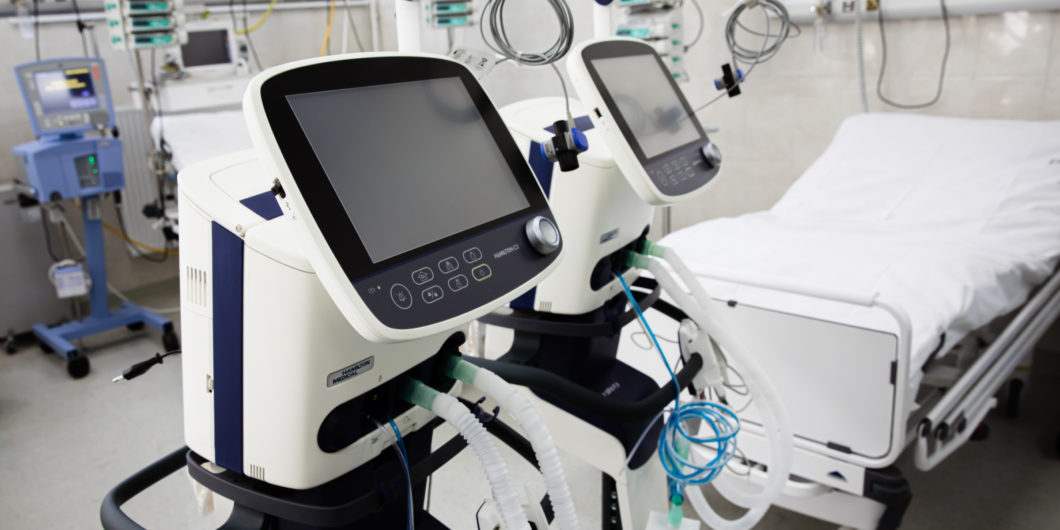The more positively we spin disruption, the more likely we are to induce or prolong it so as to make it a launching point for social change.
How Many Hospital Beds Are Enough?
The point of “flattening the curve” of coronavirus cases and the “shutdown” happening around the US is to make sure we don’t overwhelm the hospital system. If we let up, is that going to happen?
The answer depends on three numbers: the number of people who will be infected, the number of people who will need hospitalization, and the number of hospital beds available. The first two are both unknowns, so experts are using data from China and projections based on models to make guesses. The third can be estimated. In this essay, I make use of projections epidemiologists and public health experts are using, as well as current hospitalization levels in the US, to get a sense of plausible caseloads that may face hospital systems over the next year, specifically in the service area where I live, to see if they will be overwhelmed.
Epidemiology professor Marc Lipsitch has projected that between 20% and 60% of people will be infected globally—a huge range. Public health experts and commentators like Ari Schulman are settling on a “moderate” estimate that, absent significant collective measures to reduce the spread, the disease will infect about 40% of us. In terms of hospitalization, a common estimate is that about 20% of us will need to go to the hospital.
Thomas C. Tsai, Benjamin H. Jacobson, and Ashish K. Jha, researchers at Harvard’s Global Health Institute, conclude in Health Affairs that, based on these projections, the hospital system will be overwhelmed over the next year, even with some flattening of the curve, facing an overall caseload far exceeding capacity. There are different predictions if the infection prevalence is only 20%. If that the lower bound is realized and the curve is flattened, such that cases are spread out over a year as opposed to concentrated in the initial six-month period, then they predict that US hospitals can handle the caseload with current capacity.
Annie Waldman, Al Shaw, Ash Ngu, and Sean Campbell at ProPublica have generated heat maps visualizing these results. These maps show the percentage of available hospital beds that will be filled across the country in nine different scenarios, varying by both the infection prevalence (20%, 40%, and 60%) and temporal concentration of cases (6, 12, and 18 months). Orange and red are bad, indicating that caseload exceeds capacity in a region. If 40% infection prevalence or higher occurs, at least some regions of the country are overwhelmed, and it gets worse as cases are temporally concentrated and infection prevalence increases.
So where do these projections come from? The 40% infection prevalence estimate, the mid-point of Lipsitch’s projection range, is based on modeling that draws from previous viral epidemics. The 20% hospitalization rate is based on the percentage of people who needed hospitalization in China as of February 24. Near as I can tell, it comes from adding up “critical” and “severe” cases to that point.
There is reason to think the 20% estimate, based on the initial outbreak in China, might be too high. The percentage of people who tested positive for the virus that had been hospitalized in the US was 12% as of March 16, according to the CDC. In New York the figure is 13% as of March 23, according to NPR. Even that percentage might be higher than overall hospitalization rates end up looking, since it only includes people who have tested positive in the denominator. I would expect it to decrease as testing increases. This is a key figure to watch.
Hospital capacity varies by region, so this analysis has to be done at the city or county level. Data and analysis that a team of people from Harvard’s Global Health Institute, ProPublica, and the New York Times put together enable us to do this. You can view the full dataset with the state as the unit of analysis here, with predictions regarding overload based on different levels of infection prevalence and the 20% hospitalization estimate.
Waldman, Shaw, Ngu, and Campbell let us see what this means at the level of Hospital Referral Regions (HRRs). To show you how I’m thinking about this, I use Bryan, TX where I live. The Bryan HRR also includes College Station, home of Texas A&M University, and some surrounding areas. The HRR has a population of 292,000 and a total of 580 beds. Of those, about 45% were occupied as of 2018, leaving 320 available (55%). That’s important—other illnesses and medical needs won’t take a break over the next year. Bryan’s percentage of occupied beds appears to be low—the average occupancy rate around the country is around 64-65%. About that percentage of the Houston HRR’s beds were occupied already, and about 79% of New York’s. Even though there is a lag, this data accounts for other medical services that hospitals will be called on to provide.
So, the unoccupied 320 beds in the Bryan HRR leave 116,800 available bed-days over the course of one year, 365 days. To break even—to be able to give everyone who needs a hospital bed 12 bed-days, which is the average stay for hospitalized patients in China—the number of people requiring hospitalization over the course of the year from coronavirus would have to be about 9,733, evenly spread out. That’s the magic number.
What follows is a series of rough-and-ready calculations of how many beds the Bryan HRR will need over the year, assuming cases are evenly spread over a year, but with different infection and hospitalization rates. I compare the caseload for these scenarios to the break-even number. Spoiler: if the middling infection prevalence of 40% is right, the virus will overwhelm the Bryan HRR’s available hospital beds. That’s true even with a 12% hospitalization rate. On the other hand, if infection prevalence is only 20%, and the hospitalization rate is 12%, the Bryan HRR is in the clear.
I am not quite sure how the ProPublica analysts come up with estimates of how many people will need hospitalization. The text of the article suggests they are using the 20% hospitalization estimate, but in reporting results for HRRs, they estimate 8% of the adult will need a hospital. I simply take the 20% estimate and apply it to the entire number of infected people.
If 40% of the population gets infected over the next year, that’s 116,800 people. (It’s just coincidence that it’s the same as the number of total bed-days available.) If 20% of those infected will need hospitalization, that’s 23,360—well above the break-even number of 9,733. We need 280,320 bed-days over the year, so we’re short by 163,520 bed-days, or 448 beds (bed-days/365 days). We need to more than double the beds, in fact.
But what if the hospitalization rate is 12%? Now 14,016 people need to be hospitalized over the next year, for 12 days. That’s 168,192 bed-days. We’re still exceeding capacity by 51,392 bed-days, short about 140 beds. Closer, though.
What if 20% get infected, and 20% of those need hospitalization? Now 58,400 people have the virus and 11,680 need to be hospitalized. Still too many, short about 64 beds.
Finally, the good (well, better) news: if 20% get infected and only 12% need hospitalization, that’s 7,008 needing hospitalization. The Bryan HRR should be fine.
According to the modeling, that’s an optimistic prediction. It relies on a lower hospitalization level than many experts are using, albeit one I think is reasonable.
I made similar calculations for the Houston HRR, and that megacity would still exceed hospitalization capacity with these lower bounds. With 20% prevalence, Houston would need the hospitalization rate to be about 9% to break even. That’s not out of the realm of possibility, but is lower than the most recent figure from the CDC.
This analysis is blunt, and there are a number of limitations—in addition to the fact that I’ve only looked at a couple of cities. It doesn’t differentiate by age group, which will matter because people over 60 are more likely to need hospitalization. It doesn’t account for temporal variation in hospitalization rates; what if we get a sudden upswing in a month? There are also other elements of hospital capacity that will be crucial for this virus, related to ICU beds and ventilators. One other tricky factor is that higher infection prevalence might also decrease capacity, not in terms of beds but in terms of staff if they get infected.
The question naturally arises as to whether there is a connection between the shutdown and the infection prevalence level.
Importantly, all of the above assumes we can’t add or free up more hospital beds or boost capacity in other ways, which state governments are already working on, by adding beds or postponing elective surgeries. That’s a ‘good’ limitation, albeit of little comfort in places like New York, where Governor Andrew Cuomo is reportedly mandating hospitals to increase bed capacity by 50% or more out of desperation.
With all these limitations and caveats in mind, I think we can draw some tentative conclusions. The coronavirus, if it acts like many experts are saying it will, presents a serious challenge in terms of hospital capacity. If the predictions of 40% prevalence and a 20% hospitalization level hold, Schulman and others who say we have to keep the shutdown going for a while are on solid ground in that we can expect hospitals to be overwhelmed if we don’t mitigate the spread, add more capacity, or both. If, on the other hand, the more optimistic predictions are right, lots of HRRs will probably be okay. If the spread of the virus tends toward the infection rate of 20%, the lower bound of Lipsitch’s projection, and hospitalization rates are low enough, US hospitals should be fine, even in heavily populated areas like Houston.
The question naturally arises as to whether there is a connection between the shutdown and the infection prevalence level. How crucial is a prolonged shutdown to pushing the prevalence rate to 20% and spreading out the cases over the year? If it’s crucial, how long would a shutdown have to last to be effective? I don’t know the answers. From what I can tell, the prevalence estimate of 40% is based on assumptions of very limited mitigation efforts. The Harvard researchers seem to think that pushing prevalence to the lower levels may require sustained efforts in the early days to ensure social distancing. Ultimately, we don’t really know what the effect of the shutdown is on the infection rate and the curve, since we do not know the infection rate.
Is there a via media? Could we keep the infection rate down while allowing more economic activity to occur, by maintaining social distancing short of shelter-in-home or lockdown and keeping vulnerable populations at home? That seems plausible, but I don’t know. If we go that route, we should boost hospital capacity. While this analysis is not dispositive of when and how to open the economy, it does give us reason to think the virus could overwhelm US hospitals’ current capacity. Unless optimistic projections are realized, continued measures to reduce spread, boosting hospital capacity, or both will be required to prevent caseload from exceeding capacity.



